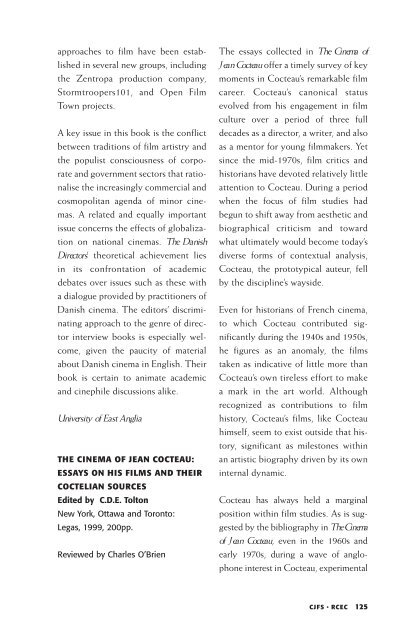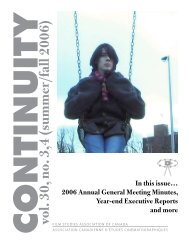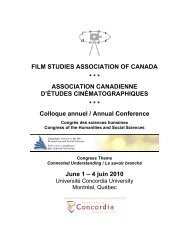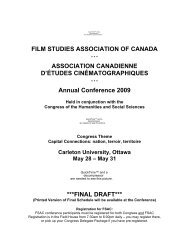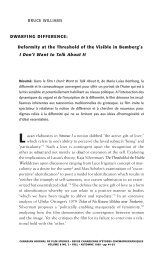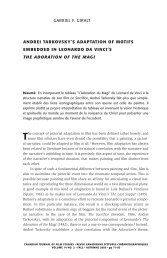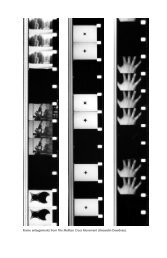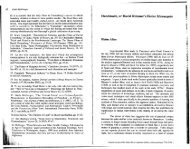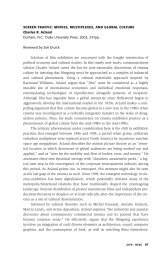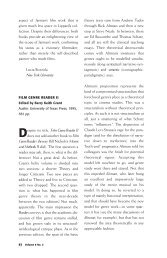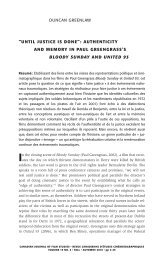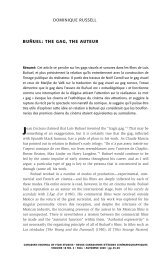PDF: The Cinema of Jean Cocteau: Essays on his Films and their ...
PDF: The Cinema of Jean Cocteau: Essays on his Films and their ...
PDF: The Cinema of Jean Cocteau: Essays on his Films and their ...
Create successful ePaper yourself
Turn your PDF publications into a flip-book with our unique Google optimized e-Paper software.
approaches to film have been established<br />
in several new groups, including<br />
the Zentropa producti<strong>on</strong> company,<br />
Stormtroopers101, <strong>and</strong> Open Film<br />
Town projects.<br />
A key issue in t<strong>his</strong> book is the c<strong>on</strong>flict<br />
between traditi<strong>on</strong>s <str<strong>on</strong>g>of</str<strong>on</strong>g> film artistry <strong>and</strong><br />
the populist c<strong>on</strong>sciousness <str<strong>on</strong>g>of</str<strong>on</strong>g> corporate<br />
<strong>and</strong> government sectors that rati<strong>on</strong>alise<br />
the increasingly commercial <strong>and</strong><br />
cosmopolitan agenda <str<strong>on</strong>g>of</str<strong>on</strong>g> minor cinemas.<br />
A related <strong>and</strong> equally important<br />
issue c<strong>on</strong>cerns the effects <str<strong>on</strong>g>of</str<strong>on</strong>g> globalizati<strong>on</strong><br />
<strong>on</strong> nati<strong>on</strong>al cinemas. <str<strong>on</strong>g>The</str<strong>on</strong>g> Danish<br />
Directors’ theoretical achievement lies<br />
in its c<strong>on</strong>fr<strong>on</strong>tati<strong>on</strong> <str<strong>on</strong>g>of</str<strong>on</strong>g> academic<br />
debates over issues such as these with<br />
a dialogue provided by practiti<strong>on</strong>ers <str<strong>on</strong>g>of</str<strong>on</strong>g><br />
Danish cinema. <str<strong>on</strong>g>The</str<strong>on</strong>g> editors’ discriminating<br />
approach to the genre <str<strong>on</strong>g>of</str<strong>on</strong>g> director<br />
interview books is especially welcome,<br />
given the paucity <str<strong>on</strong>g>of</str<strong>on</strong>g> material<br />
about Danish cinema in English. <str<strong>on</strong>g>The</str<strong>on</strong>g>ir<br />
book is certain to animate academic<br />
<strong>and</strong> cinephile discussi<strong>on</strong>s alike.<br />
University <str<strong>on</strong>g>of</str<strong>on</strong>g> East Anglia<br />
THE CINEMA OF JEAN COCTEAU:<br />
ESSAYS ON HIS FILMS AND THEIR<br />
COCTELIAN SOURCES<br />
Edited by C.D.E. Tolt<strong>on</strong><br />
New York, Ottawa <strong>and</strong> Tor<strong>on</strong>to:<br />
Legas, 1999, 200pp.<br />
Reviewed by Charles O’Brien<br />
<str<strong>on</strong>g>The</str<strong>on</strong>g> essays collected in <str<strong>on</strong>g>The</str<strong>on</strong>g> <str<strong>on</strong>g>Cinema</str<strong>on</strong>g> <str<strong>on</strong>g>of</str<strong>on</strong>g><br />
<str<strong>on</strong>g>Jean</str<strong>on</strong>g> <str<strong>on</strong>g>Cocteau</str<strong>on</strong>g> <str<strong>on</strong>g>of</str<strong>on</strong>g>fer a timely survey <str<strong>on</strong>g>of</str<strong>on</strong>g> key<br />
moments in <str<strong>on</strong>g>Cocteau</str<strong>on</strong>g>’s remarkable film<br />
career. <str<strong>on</strong>g>Cocteau</str<strong>on</strong>g>’s can<strong>on</strong>ical status<br />
evolved from <strong>his</strong> engagement in film<br />
culture over a period <str<strong>on</strong>g>of</str<strong>on</strong>g> three full<br />
decades as a director, a writer, <strong>and</strong> also<br />
as a mentor for young filmmakers. Yet<br />
since the mid-1970s, film critics <strong>and</strong><br />
<strong>his</strong>torians have devoted relatively little<br />
attenti<strong>on</strong> to <str<strong>on</strong>g>Cocteau</str<strong>on</strong>g>. During a period<br />
when the focus <str<strong>on</strong>g>of</str<strong>on</strong>g> film studies had<br />
begun to shift away from aes thetic <strong>and</strong><br />
biographical criticism <strong>and</strong> toward<br />
what ultimately would become today’s<br />
diverse forms <str<strong>on</strong>g>of</str<strong>on</strong>g> c<strong>on</strong>textual analysis,<br />
<str<strong>on</strong>g>Cocteau</str<strong>on</strong>g>, the prototypical auteur, fell<br />
by the discipline’s wayside.<br />
Even for <strong>his</strong>torians <str<strong>on</strong>g>of</str<strong>on</strong>g> French cinema,<br />
to which <str<strong>on</strong>g>Cocteau</str<strong>on</strong>g> c<strong>on</strong>tributed sig -<br />
nificantly during the 1940s <strong>and</strong> 1950s,<br />
he figures as an anomaly, the films<br />
taken as indicative <str<strong>on</strong>g>of</str<strong>on</strong>g> little more than<br />
<str<strong>on</strong>g>Cocteau</str<strong>on</strong>g>’s own tireless effort to make<br />
a mark in the art world. Although<br />
recognized as c<strong>on</strong>tributi<strong>on</strong>s to film<br />
<strong>his</strong>tory, <str<strong>on</strong>g>Cocteau</str<strong>on</strong>g>’s films, like <str<strong>on</strong>g>Cocteau</str<strong>on</strong>g><br />
himself, seem to exist outside that <strong>his</strong>tory,<br />
significant as milest<strong>on</strong>es within<br />
an artistic biography driven by its own<br />
internal dynamic.<br />
<str<strong>on</strong>g>Cocteau</str<strong>on</strong>g> has always held a marginal<br />
positi<strong>on</strong> within film studies. As is suggested<br />
by the bibliography in <str<strong>on</strong>g>The</str<strong>on</strong>g> <str<strong>on</strong>g>Cinema</str<strong>on</strong>g><br />
<str<strong>on</strong>g>of</str<strong>on</strong>g> <str<strong>on</strong>g>Jean</str<strong>on</strong>g> <str<strong>on</strong>g>Cocteau</str<strong>on</strong>g>, even in the 1960s <strong>and</strong><br />
early 1970s, during a wave <str<strong>on</strong>g>of</str<strong>on</strong>g> angloph<strong>on</strong>e<br />
interest in <str<strong>on</strong>g>Cocteau</str<strong>on</strong>g>, experimental<br />
CJFS • RCEC 125
filmmakers <strong>and</strong> literary critics as much<br />
as film critics were drawn to <str<strong>on</strong>g>Cocteau</str<strong>on</strong>g>’s<br />
films. As Cam Tolt<strong>on</strong> observes in <strong>his</strong><br />
introducti<strong>on</strong> to <str<strong>on</strong>g>The</str<strong>on</strong>g> <str<strong>on</strong>g>Cinema</str<strong>on</strong>g> <str<strong>on</strong>g>of</str<strong>on</strong>g> <str<strong>on</strong>g>Jean</str<strong>on</strong>g><br />
<str<strong>on</strong>g>Cocteau</str<strong>on</strong>g>, <str<strong>on</strong>g>Cocteau</str<strong>on</strong>g> ranks am<strong>on</strong>g the<br />
most literary <str<strong>on</strong>g>of</str<strong>on</strong>g> filmmakers, <strong>and</strong> still<br />
today <strong>his</strong> films remain accessible largely<br />
through <strong>his</strong> own well-crafted self-image<br />
as romantic poet.<br />
T<strong>his</strong> image had taken form some two<br />
decades before <str<strong>on</strong>g>Cocteau</str<strong>on</strong>g> directed <strong>his</strong><br />
first film, Le sang d’un poète (1930/1932)<br />
at age forty-<strong>on</strong>e. By then, after nearly<br />
twenty-five years <str<strong>on</strong>g>of</str<strong>on</strong>g> published writing,<br />
al<strong>on</strong>g with diverse drawings, theatrical<br />
producti<strong>on</strong>s, libretti, stage designs,<br />
<strong>and</strong> murals, including collaborati<strong>on</strong>s<br />
with artists such as Diaghilev, Picasso,<br />
Satie <strong>and</strong> others, <str<strong>on</strong>g>Cocteau</str<strong>on</strong>g> was an<br />
internati<strong>on</strong>al celebrity. From the start,<br />
<str<strong>on</strong>g>Cocteau</str<strong>on</strong>g>’s work in film would amount<br />
to <strong>on</strong>ly <strong>on</strong>e facet <str<strong>on</strong>g>of</str<strong>on</strong>g> a lifel<strong>on</strong>g commitment<br />
to “poetic” expressi<strong>on</strong>.<br />
<str<strong>on</strong>g>The</str<strong>on</strong>g> critical essays collected in <str<strong>on</strong>g>The</str<strong>on</strong>g><br />
<str<strong>on</strong>g>Cinema</str<strong>on</strong>g> <str<strong>on</strong>g>of</str<strong>on</strong>g> <str<strong>on</strong>g>Jean</str<strong>on</strong>g> <str<strong>on</strong>g>Cocteau</str<strong>on</strong>g> deal with eight<br />
films written <strong>and</strong>/or directed by<br />
<str<strong>on</strong>g>Cocteau</str<strong>on</strong>g>, relating them to <strong>his</strong> life <strong>and</strong><br />
to <strong>his</strong> work in other media, especially<br />
theatre. Written by students in<br />
Tolt<strong>on</strong>’s 1997 graduate seminar at the<br />
University <str<strong>on</strong>g>of</str<strong>on</strong>g> Tor<strong>on</strong>to, the analyses in<br />
<str<strong>on</strong>g>The</str<strong>on</strong>g> <str<strong>on</strong>g>Cinema</str<strong>on</strong>g> <str<strong>on</strong>g>of</str<strong>on</strong>g> <str<strong>on</strong>g>Jean</str<strong>on</strong>g> <str<strong>on</strong>g>Cocteau</str<strong>on</strong>g> amount, for<br />
the most part, to applicati<strong>on</strong>s <str<strong>on</strong>g>of</str<strong>on</strong>g> various<br />
critical methods to the study <str<strong>on</strong>g>of</str<strong>on</strong>g><br />
individual films. Updated versi<strong>on</strong>s <str<strong>on</strong>g>of</str<strong>on</strong>g><br />
traditi<strong>on</strong>al critical approaches include<br />
Tanya Angers’ discussi<strong>on</strong> <str<strong>on</strong>g>of</str<strong>on</strong>g> Coctelian<br />
126 Volume 10 No. 1<br />
noti<strong>on</strong>s <str<strong>on</strong>g>of</str<strong>on</strong>g> poetic creati<strong>on</strong> in Le sang<br />
d’un poète <strong>and</strong> Mima Vulovic’s study <str<strong>on</strong>g>of</str<strong>on</strong>g><br />
<str<strong>on</strong>g>Cocteau</str<strong>on</strong>g>’s revisi<strong>on</strong> <str<strong>on</strong>g>of</str<strong>on</strong>g> the orphic myth<br />
in Orphée (1950). Other pieces apply<br />
more c<strong>on</strong>temporary critical approaches<br />
to <str<strong>on</strong>g>Cocteau</str<strong>on</strong>g>’s films <strong>and</strong> plays.<br />
Examples include Iain A. Hill’s study <str<strong>on</strong>g>of</str<strong>on</strong>g><br />
the “masoc<strong>his</strong>tic aesthetic” <str<strong>on</strong>g>of</str<strong>on</strong>g> Le testa ment<br />
d’Orphée (1960), Rebecca C<strong>on</strong>olly’s<br />
feminist critique <str<strong>on</strong>g>of</str<strong>on</strong>g> Orphée, Tamara<br />
El-Hoss’ narratological analysis <str<strong>on</strong>g>of</str<strong>on</strong>g> the<br />
play Les parents terribles (1938), Jacob<br />
Kruger’s “Lacanian approach” to the<br />
autobiographical aspects <str<strong>on</strong>g>of</str<strong>on</strong>g> the film<br />
versi<strong>on</strong> <str<strong>on</strong>g>of</str<strong>on</strong>g> Les parents terribles (1948), <strong>and</strong><br />
Dario Del Degan’s survey <str<strong>on</strong>g>of</str<strong>on</strong>g> Sartrian<br />
themes in La belle et la bête(1946).<br />
<str<strong>on</strong>g>The</str<strong>on</strong>g> individual pieces are especially<br />
rewarding when attuned to dimensi<strong>on</strong>s<br />
<str<strong>on</strong>g>of</str<strong>on</strong>g> <str<strong>on</strong>g>Cocteau</str<strong>on</strong>g>’s films that prove<br />
resistant to the methods brought to<br />
bear <strong>on</strong> them, as in Roxanne Chee’s<br />
psychoanalytic analysis <str<strong>on</strong>g>of</str<strong>on</strong>g> Les enfants<br />
terribles (1950, <str<strong>on</strong>g>Jean</str<strong>on</strong>g>-Pierre Melville),<br />
based <strong>on</strong> a <str<strong>on</strong>g>Cocteau</str<strong>on</strong>g> novel. In t<strong>his</strong> case,<br />
the critical project might be said to<br />
become self-critical, with the strangeness<br />
<str<strong>on</strong>g>of</str<strong>on</strong>g> the films’ images <strong>and</strong> sounds<br />
revealing the limits <str<strong>on</strong>g>of</str<strong>on</strong>g> a pre-made c<strong>on</strong>ceptual<br />
framework. Rather than c<strong>on</strong>firm<br />
familiar theories, <str<strong>on</strong>g>Cocteau</str<strong>on</strong>g>’s films<br />
may in fact push us to think about film<br />
in new ways.<br />
But the most impressive feature <str<strong>on</strong>g>of</str<strong>on</strong>g><br />
<str<strong>on</strong>g>The</str<strong>on</strong>g> <str<strong>on</strong>g>Cinema</str<strong>on</strong>g> <str<strong>on</strong>g>of</str<strong>on</strong>g> <str<strong>on</strong>g>Jean</str<strong>on</strong>g> <str<strong>on</strong>g>Cocteau</str<strong>on</strong>g> is perhaps<br />
what the ensemble <str<strong>on</strong>g>of</str<strong>on</strong>g> pieces suggests<br />
regarding the potential for further
work <strong>on</strong> <str<strong>on</strong>g>Cocteau</str<strong>on</strong>g>’s cinema. Here<br />
<str<strong>on</strong>g>The</str<strong>on</strong>g> <str<strong>on</strong>g>Cinema</str<strong>on</strong>g> <str<strong>on</strong>g>of</str<strong>on</strong>g> <str<strong>on</strong>g>Jean</str<strong>on</strong>g> <str<strong>on</strong>g>Cocteau</str<strong>on</strong>g> would have<br />
benefited from the inclusi<strong>on</strong> <str<strong>on</strong>g>of</str<strong>on</strong>g> a<br />
filmography, which would clarify the<br />
chr<strong>on</strong>ology as well as the extent <str<strong>on</strong>g>of</str<strong>on</strong>g> the<br />
c<strong>on</strong>tributi<strong>on</strong>s <str<strong>on</strong>g>of</str<strong>on</strong>g> l<strong>on</strong>g-time collaborators<br />
such as composer Georges Auric<br />
<strong>and</strong> set designer Christian Bérard.<br />
In reading t<strong>his</strong> collecti<strong>on</strong>, <strong>on</strong>e is<br />
reminded <str<strong>on</strong>g>of</str<strong>on</strong>g> the strength <str<strong>on</strong>g>of</str<strong>on</strong>g> the artistic<br />
achievement <str<strong>on</strong>g>of</str<strong>on</strong>g> films such as Le sang<br />
d’un poète, La belle et la bête, <strong>and</strong> Orphée.<br />
Images <str<strong>on</strong>g>of</str<strong>on</strong>g> human figures passing<br />
through mirrors, portraits that come<br />
to life, <strong>and</strong> fantastic disappearances<br />
<strong>and</strong> human/animal transformati<strong>on</strong>s à<br />
la Georges Méliès remain as impressive<br />
as ever. Regardless <str<strong>on</strong>g>of</str<strong>on</strong>g> <str<strong>on</strong>g>Cocteau</str<strong>on</strong>g>’s<br />
literary reputati<strong>on</strong>, or <strong>his</strong> feigned<br />
naïveté c<strong>on</strong>cerning film technique,<br />
<str<strong>on</strong>g>Cocteau</str<strong>on</strong>g>’s most enduring achievements<br />
may well have been in film, as<br />
Tolt<strong>on</strong> proposes. At the same time,<br />
however, the strength <str<strong>on</strong>g>of</str<strong>on</strong>g> the artistic<br />
accomplishment underscores how little<br />
is known about certain aspects <str<strong>on</strong>g>of</str<strong>on</strong>g><br />
<str<strong>on</strong>g>Cocteau</str<strong>on</strong>g>’s film career, notwithst<strong>and</strong>ing<br />
<strong>his</strong> c<strong>on</strong>siderable fame <strong>and</strong> notoriety.<br />
For instance, <strong>on</strong>e would like to know<br />
more about <str<strong>on</strong>g>Cocteau</str<strong>on</strong>g>’s work in cinema<br />
during the 1940s, when after a ten-year<br />
hiatus from filmmaking, he began<br />
writing scripts for Bress<strong>on</strong> <strong>and</strong> others,<br />
creating roles for <strong>his</strong> compani<strong>on</strong>,<br />
the actor <strong>and</strong> so<strong>on</strong>-to-be film star<br />
<str<strong>on</strong>g>Jean</str<strong>on</strong>g> Marais. Relevant here are<br />
Sara Maclean’s piece <strong>on</strong> <str<strong>on</strong>g>Cocteau</str<strong>on</strong>g>’s<br />
“modernized” adaptati<strong>on</strong> <str<strong>on</strong>g>of</str<strong>on</strong>g> Tristan et<br />
Iseult in L’éternel retour (1943, <str<strong>on</strong>g>Jean</str<strong>on</strong>g><br />
Dellanoy), <strong>and</strong> Andrea Scott’s analysis<br />
<str<strong>on</strong>g>of</str<strong>on</strong>g> structural differences between<br />
<str<strong>on</strong>g>Cocteau</str<strong>on</strong>g>’s play L’aigle à deux têtes (1943)<br />
<strong>and</strong> <strong>his</strong> filmic adaptati<strong>on</strong> <str<strong>on</strong>g>of</str<strong>on</strong>g> the same<br />
title (1947), which he also directed.<br />
Both pieces raise issues c<strong>on</strong>cerning<br />
<str<strong>on</strong>g>Cocteau</str<strong>on</strong>g>’s c<strong>on</strong>tributi<strong>on</strong>s to occupati<strong>on</strong>-era<br />
currents in film modernism<br />
that merit further study.<br />
Additi<strong>on</strong>al topics for further inquiry<br />
include <str<strong>on</strong>g>Cocteau</str<strong>on</strong>g>’s internati<strong>on</strong>al pr<str<strong>on</strong>g>of</str<strong>on</strong>g>ile<br />
during the first decade after the war,<br />
when he was involved in countless<br />
film-related projects. A beginning can<br />
be found in Wade Lynch’s piece <strong>on</strong><br />
Broadway <strong>and</strong> <str<strong>on</strong>g>of</str<strong>on</strong>g>f-Broadway producti<strong>on</strong>s<br />
<str<strong>on</strong>g>of</str<strong>on</strong>g> the play L’aigle à deux têtes. Still,<br />
questi<strong>on</strong>s remain regarding <str<strong>on</strong>g>Cocteau</str<strong>on</strong>g>’s<br />
centrality within the internati<strong>on</strong>al<br />
avant-garde. Appropriate in light <str<strong>on</strong>g>of</str<strong>on</strong>g><br />
a student-oriented project such as<br />
<str<strong>on</strong>g>The</str<strong>on</strong>g> <str<strong>on</strong>g>Cinema</str<strong>on</strong>g> <str<strong>on</strong>g>of</str<strong>on</strong>g> <str<strong>on</strong>g>Jean</str<strong>on</strong>g> <str<strong>on</strong>g>Cocteau</str<strong>on</strong>g> might be an<br />
inquiry into the circumstances <str<strong>on</strong>g>of</str<strong>on</strong>g> <strong>his</strong><br />
role during the 1950s as a mentor for<br />
young filmmakers, from <str<strong>on</strong>g>Jean</str<strong>on</strong>g>-Luc<br />
Godard to Kenneth Anger, Claude<br />
Jutra, <strong>and</strong> many others (“He helped<br />
every<strong>on</strong>e,” according to Truffaut).<br />
Marginal to the cinema’s mainstream—<strong>and</strong><br />
to film studies’ mainstream—<str<strong>on</strong>g>Cocteau</str<strong>on</strong>g><br />
n<strong>on</strong>etheless functi<strong>on</strong>ed<br />
as the hub <str<strong>on</strong>g>of</str<strong>on</strong>g> the internati<strong>on</strong>al<br />
avant-garde film culture that <strong>his</strong> lifetime<br />
<str<strong>on</strong>g>of</str<strong>on</strong>g> poetic commitment helped to<br />
bring forth.<br />
Carlet<strong>on</strong> University<br />
CJFS • RCEC 127


